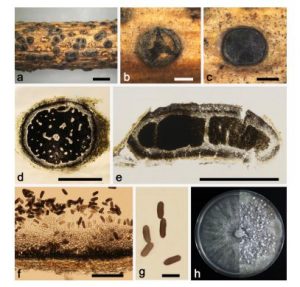Aplosporella ginkgonis C.M. Tian, Z. Du & K.D. Hyde, sp. nov. Index Fungorum number: IF552938
Etymology : Named after the host genus, Ginkgo biloba.
Holotype : BJFC-S939.
Host/Distribution : from branches of Ginkgo biloba in China.
Diagnoses : The asexual morph of Aplosporella ginkgonis is similar to Aplosporella macropycnidia Zh. P. Dou & Y. Zhang, which is from Cerasus yedoensis in China (Dou et al. 2017), but differs in its smaller pycnidia (59–63 × 77–81 μm vs. 45–180 × 38–138 μm)
Sexual morph: Undetermined. Asexual morph: Conidiomatal stromata immersed in bark, erumpent from surface of the bark, separate, discoid, dark-brown to black, multiloculate, up to 850 µm diam., wall consisting of 8–12 layers, outer layers thick composed of dark-brown textura angularis, becoming hyaline and thin-walled towards the inner region. Disc brown to black, circular to ovoid, (0.28–) 0.31–0.40(–0.44) mm (average = 0.36 mm, n = 20), with one to four ostioles per disc. Ostioles multiple, conspicuous, at the same level as the disc surface, covered below disc by lighter entostroma sometimes, (22.5–)23.9–30.7(–32.6) µm (average = 28 µm, n = 20) in diam. Locules multiple, irregularly arranged, subdivided frequently by invaginations with common walls, (0.59–)0.63–0.77(–0.81) mm (average = 0.71 mm, n = 20) in diam. Conidiogenous cells formed from the cells lining the inner walls of the locules, hyaline, smooth, inconspicuous. Conidia aseptate, ellipsoid to oblong, smooth, ends rounded, initial hyaline, becoming brown when mature, (15.5–)16–20.5(–21) × (5.5–)6.0–7.5(–8) µm (average = 17.5 × 6.5 µm, n = 50).
Cultures : Cultures growth on PDA were initially white later producing a brown pigment on the reverse side after 7–10 days. Colonies were uniform with abundant white aerial mycelium.
Materials examined : CHINA. Gansu: Qingyang City, Qingyang Municipal Government, 35°42’23.21″ N, 107°38’15.46″ E, 1420 m asl., on stems of Ginkgo biloba, 14 Jul. 2013, collected by X.L. Fan (holotype, BJFC-S939, ex-type living culture, CFCC 89661); CHINA. Gansu, Qingyang City, Heshui County, 35°46’49.49″N, 107°59’31.48″ E, 1277 m asl., on stems of Morus alba, collected by X.L. Fan, 13Jul. 2013, BJFC-S917, single conidium living culture CFCC 89660.
Notes : Morphologically, Aplosporella ginkgonis is characterized by its multilocular conidiomata with one to four ostioles, and aseptate, brown, ellipsoid to oblong conidia. Phylogenetically, two samples of A. ginkgonis formed a distinct lineage with high support (MP/BI = 100/1) in the combined ITS and tef1-α analysis. Strains CFCC 89660 and 89661 had been misidentified as A. longipes based on host association; however, these strains differ by their larger conidia (16–20.5 × 6–7.5 vs 12–20 × 5–6 µm) and represent a unique species of Aplosporella from Ginkgo biloba (Saccardo 1899). Both morphology and the sequence data confirmed that the two samples represent a new species in Aplosporella using the guidelines for new species in Jeewon & Hyde (2016).
FIG 2. Morphology of Aplosporella ginkgonis. A Habit of conidiomata on twig; B Multiostioles on the disc of conidiomata; C, D Transverse sections through conidiomata; E Longitudinal sections through conidiomata; F Conidiogenous cells and conidia; G Conidia; H Colonies on PDA at 3 days (left) and 30 days (right); Scale bars: A = 2 mm; B–E = 0.5 mm; F = 100 μm; G = 20 μm.

